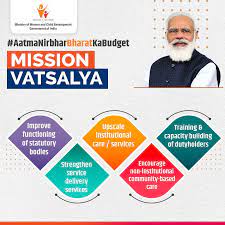11 Jul 2022 Mission Vatsalya Child Protection Scheme

- Recently, the Central Government had issued guidelines to the states regarding the Mission Vatsalya Child Protection Scheme.
New Guidelines:
- As per the guidelines, states cannot change the original name of the scheme to get access to the funds given by the central government.
- Funds to the states will be approved through the Mission Vatsalya Project Approval Board (PAB), headed by the WCD Secretary, who will scrutinize and approve the annual plans and financial proposals received from the states and union territories for release of grants.
- It will be implemented as a Centrally Sponsored Scheme in partnership with State Governments and UT Administrations with a fund-sharing pattern in the ratio of 60:40.
- However, for the eight states of the Northeast as well as Himachal Pradesh, Uttarakhand and the Union Territory of Jammu and Kashmir, the share of the Center and the State/UT will be in 90:10.
- The MVS, in partnership with the states and districts, will implement a 24×7 helpline service for children, as defined under the Juvenile Justice Act, 2015.
- It will support the State Adoption Resource Agencies (SARAs) which will support the Central Adoption Resource Authority (CARA) in promoting adoption in the country and regulating inter-country adoptions.
- SARA will coordinate, monitor and develop activities related to non-institutional care including adoption in the state.
- The mission plans to set up Cradle Shishu Reception Centers in at least one specialized adoption agency in each area to receive abandoned and trafficked children.
- Children in need of care as well as children with special needs will be placed in separate homes based on gender (including separate homes for transgender children) and age.
- Since they cannot attend school due to physical or mental disabilities, these institutions will provide specialized teachers, doctors and nurses to provide occupational therapy, speech therapy, verbal therapy and other remedial classes.
- In addition, the employees of these specialized divisions should be proficient in sign language, braille and other related languages.
- The state government will support the establishment of open shelters for the care of runaway children, missing children, trafficked children, working children, street children, child beggars, drug abusers, etc.
- Financial assistance has also been earmarked to support education, nutrition and health needs for vulnerable children living with extended families or in foster care.
Mission Vatsalya:
Historical perspective:
- Before 2009, the Ministry of Women and Child Development implemented three schemes for children in need of protection:
- Juvenile justice programs for children in need of care and protection as well as children,
- Integrated program for street children,
- Child Home Assistance Scheme.
- In the year 2010, these were merged into a single scheme which is known as Integrated Child Protection Scheme.
- In the year 2017 it was renamed as “Child Protection Service Scheme” and then renamed as Mission Vatsalya in the year 2021-22.
Introduction:
- This is the umbrella scheme for child protection services in the country.
- Components under Mission Vatsalya include improving the functioning of statutory bodies, strengthening service delivery structures, enhanced institutional care and services, promotion of non-institutional community-based care, services for emergency access and training and capacity building.
Purpose:
- To ensure a healthy and happy childhood for every child of the country.
- To promote a sensitive, supportive and synchronous ecosystem for the development of children, to assist the States and Union Territories in delivering the mandate of the Juvenile Justice Act, 2015 to enable them to achieve their full potential and nurture them in all respects. Achieving the Sustainable Development Goals (SDGs) to ensure opportunities to assist in
- It promotes family-based non-institutional care of children in difficult situations based on the ‘principle of institutionalization of children’ as a last resort.


No Comments